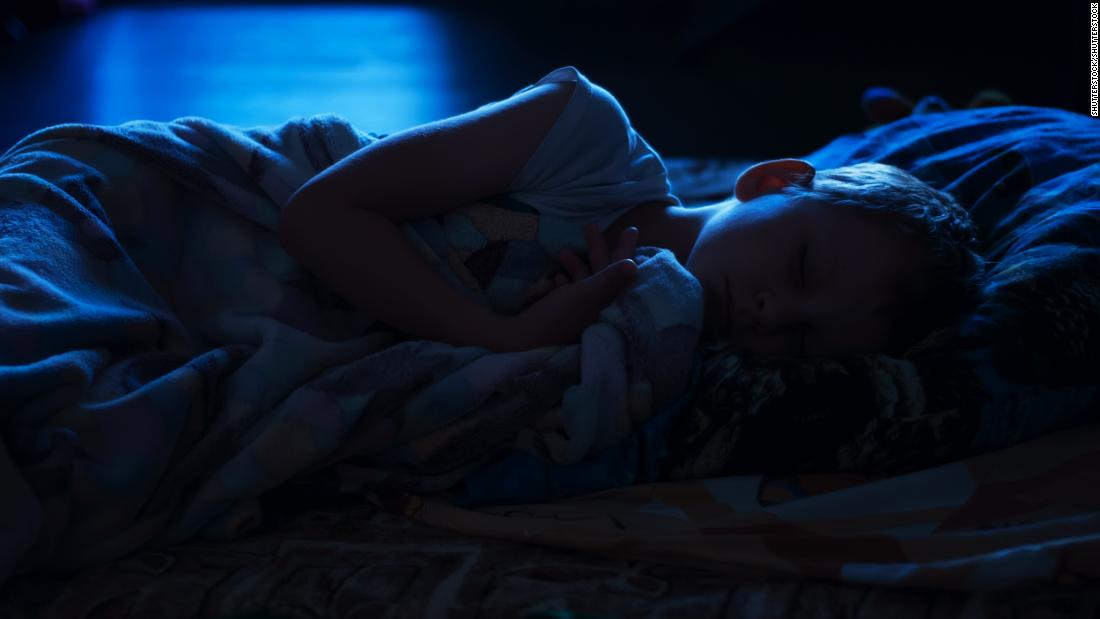How to keep your child in bed at night
How To Get Your Toddler To Stay In Their Bed All Night
Sleep Tight
It's the longest walk you'll take over and over and over again.
by Patrick A. Coleman
Updated:
Originally Published:
Making the transition from a crib to a toddler bed is a major milestone in a child’s life. But seasoned veterans know that the real challenge isn’t persuading your toddler to sleep in their exciting big-kid bed — it’s what to do when your toddler won’t stay in bed. Because with great freedom comes a great desire to wander back into a parent’s room.
So how do you keep your toddler in bed? For some parents, a toddler that won’t stay in bed is less of an issue. They have an open bed policy, and it doesn’t matter where their toddler sleeps as long as their toddler is sleeping. For other parents, alone time is crucial, and learning how to keep a toddler in bed is a top priority. Enter yet another round of sleep training — toddler edition.
Falling Asleep Independently Will Help Keep Your Toddler in Bed All Night
In the order of operations for helping a toddler stay in bed all night, getting them to a place where they fall asleep independently is at the top of the list. When you are able to leave their room while they are still awake, you know they have developed the skills to self-soothe and fall asleep independently in the first place.
“If your child needs you nearby in order to fall asleep and you leave (either because you have to go attend to something or because you think he or she is asleep), your toddler will absolutely leave the bed to come to find you,” says Dr. Lynelle Schneeberg, director of the behavioral sleep program at Connecticut Children’s Medical Center, and author of Become Your Child’s Sleep Coach: The Bedtime Doctor’s 5-Step Guide, Ages 3-10.
She explains that most kids wake up 2-6 times each night. So view bedtime as a learning opportunity for your toddler, where they develop the skills necessary to meet some of their own needs throughout the night. “If your toddler needs your help to fall asleep at bedtime and you leave only once he or she is deeply asleep,” explains Dr. Schneeberg, “your toddler will leave their bed to come and find you at night after he or she wakes as all kids do.”
“If your toddler needs your help to fall asleep at bedtime and you leave only once he or she is deeply asleep,” explains Dr. Schneeberg, “your toddler will leave their bed to come and find you at night after he or she wakes as all kids do.”
Sleep-Training Your Toddler
Sleep training a toddler goes by many names, most of which include the word “walk” in them. That’s because you’ll be walking back and forth between your bed and theirs. Maybe all night. The simple steps are:
- Complete the bedtime routine as normal, including hugs, kisses, and encouragement.
- Leave quickly without fanfare and no answering last-minute pleas or requests.
- If your kid gets up, walk them back to bed calmly, tuck them in again and remind them they need to stay in bed. Leave the room.
- If your kids get up again, walk them back to bed calmly and now silently. Tuck them into bed. Leave the room.
- Repeat.
Getting your kid to stay in bed overnight is not an easy or quick thing to do. It may take a night before it works. It might take five. But it will eventually work. The key is to remain completely calm and quiet in the face of whatever your toddler throws at you. Even if they are literally throwing things at your face.
It may take a night before it works. It might take five. But it will eventually work. The key is to remain completely calm and quiet in the face of whatever your toddler throws at you. Even if they are literally throwing things at your face.
Need motivation? Just think of the quiet nights of conversation with only you and your partner in bed. Or having sex.
Make Clear Expectations About Staying in Bed
Make sure your toddler knows what you expect from them. Dr. Schneeberg suggests using a bedtime chart if your toddler uses extra steps or requests as “If you have a chart you can say, ‘the chart says it’s time to brush teeth now’ or “hugging the dog again is not on the chart,'” she says.
Charts can be as much for the parent’s benefit as they are for the toddler’s. By bedtime, you’re tired as well and may find it a challenge to keep firm limits. “Parents sometimes think that if they grant all of the requests a child makes when they out of the room then their child will finally fall asleep,” sats Dr. Schneeberg. “In actuality, granting all of these requests actually rewards the child for staying awake.”
Schneeberg. “In actuality, granting all of these requests actually rewards the child for staying awake.”
If the rigidity of a chart isn’t the best fit for you or your toddler, Dr. Schneeberg notes that a ticket or token system might work better. Each night, your child gets two tickets that they can “spend” on a deviation from the bedtime routine. They can use a ticket on an extra book, a quick drink, or anything else within reason. “Once the two tickets are gone, parents can remind their children to return to bed to play quietly in bed with their comfort objects until they are drowsy enough to fall asleep,’ says Dr. Schneeberg.
Getting Your Toddler Back to Bed
Kids actually have rational reasons for not wanting to go to bed. Staying up is more fun than laying still, and they have a fear of missing out on the entertaining things parents or siblings do at night. Unfortunately, they also drastically miscalculate their ability to be healthy and pleasant without adequate sleep, so it really is imperative that they get back to bed.
Dr. Schneeberg notes that you’ll want to be as brief and boring as possible when returning your child to bed. “Remind your child to play with their small, safe toy or stuffed animal until he or she is sleepy,” she says. “If your child comes to your room at night, you can either let them sleep in a spare bed in your room, you can sleep in a spare bed in their room, or you can walk them back to their room and stay nearby until they are asleep again.”
Luckily, what might feel like an insurmountable challenge at the moment is, in reality, an opportunity to gently reinforce that your child has the tools to stay in bed and that it’s a safe place for them. At some point soon they will sleep through the night. And before you know it, your kid will reach the teenage years, so you’ll be looking for strategies on how to get them out of bed.
This article was originally published on
How to keep your child in their bed at night (This works!)
Today I want to talk about how to keep your child in their own bed. Let me first take a minute to explain that your child will be healthier, do better in school, be more pleasant throughout the day, and just feel better overall, if they are getting enough sleep (no matter where that may be: your bed, their bed or somewhere else).
Let me first take a minute to explain that your child will be healthier, do better in school, be more pleasant throughout the day, and just feel better overall, if they are getting enough sleep (no matter where that may be: your bed, their bed or somewhere else).
Now, we do not co-sleep (well- if the kids aren’t feeling well, if they are running a fever, or if there is a thunderstorm, they do sleep in our rooms), but for the most part, we don’t co-sleep because I am a huge worrier!
I am up all night worrying about if they are breathing or if a pillow is on their face or if they are sleeping all night or waking up. If I have to sneeze or cough- forget about it… I will just hold it because I don’t want to risk waking them.
All in all, I just don’t relax when they are in our bed. My husband won’t sleep, either, because he worries about rolling on top of them. I know that those things probably will never happen, but I just worry so much, so we all sleep better when they are in their bed and we are in our bed.
With that being said, I try to remember “Different Strokes for Different Folks”, so whatever works for your family is what works. Period!
So- let’s get back to keeping your child in their own bed. I’m not saying that my kids always sleep through the night, just that it is better for their development when they do. Trust me; my kids have all woken up for weeks or months at a time at some point during their young lives. I just do my best to get them back onto their natural sleep patterns to help them be the healthiest and happiest that they can be!
Here are the reasons that I want my child to STAY IN HIS/HER BED AT NIGHT:
- I am uncomfortable knowing that our sons or daughter would be walking around when I am asleep. I just can’t have this. What if they fell down the stairs? What if they got themselves a drink and aspirated without me knowing? What if they got into something dangerous (we keep the house child-proofed, but you just never know)? For these reasons, we have a rule that they must stay in their beds until 7:00 am .

- Kids need 10-12 hours of sleep a night. Younger toddlers and babies need even more. This is why we put our kids to bed at 7:00.
- Well-rested kids = happier kids. Well-rested kids = kids that can focus better. It just works for us.
- I don’t want to be ‘tucking them in’ five times a night. I have already had time lying down with each one of them, and they need to go to bed.
A quick background on our family. Our older two boys always stay in bed (they are six and eight).I don’t know what we did differently, but they never attempted to come out of bed. The two younger ones are still in the learning process (2 and 4).
I love the cuddle time with each one of our kids. This is why when they say “Mommy, will you lay with me?” I always say YES! However, laying with them and having them coming into my room and bed at all hours of the night are two totally different things.
I get this question a lot, so let me offer the advice that worked for us.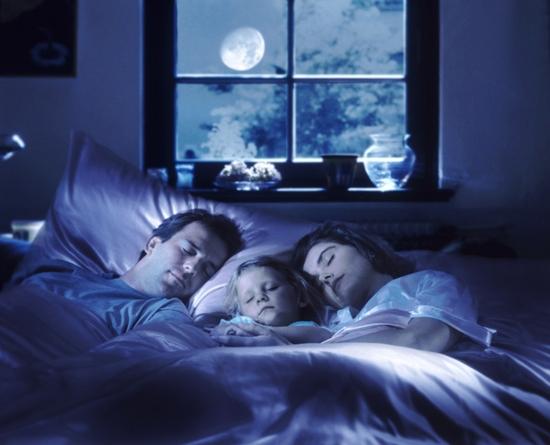
(PS- BEFORE YOU START, MAKE SURE THAT YOUR CHILD ISN’T SICK, THIRSTY, OR HAS TO USE THE BATHROOM).
The very first time that they come out of their bed, correct them.
My story: When our daughter moved to a toddler bed, I watched her on her video monitor.
The second that I saw her climbing out of her bed, I ran in and said “No, Ma’am. Back into bed, please. ” I told her “If you need Mommy, you say ‘MOMMY!’ and I will come in. You DO NOT get out of your bed. I will be scared if I know that you aren’t safe in your bed. Do you understand? ”
She answered with an “Uh-hum.” She then started to cry, knowing that she didn’t make the right choice and she put her hands over her eyes (this is what she does when she is upset). She didn’t come out of her bed again, until several months later.
Fast forward- Several months later, she made her second attempt. She is still only two, and I am not comfortable with her walking around without me knowing because it isn’t safe, so when I saw her, I put her back into her bed and said the same thing.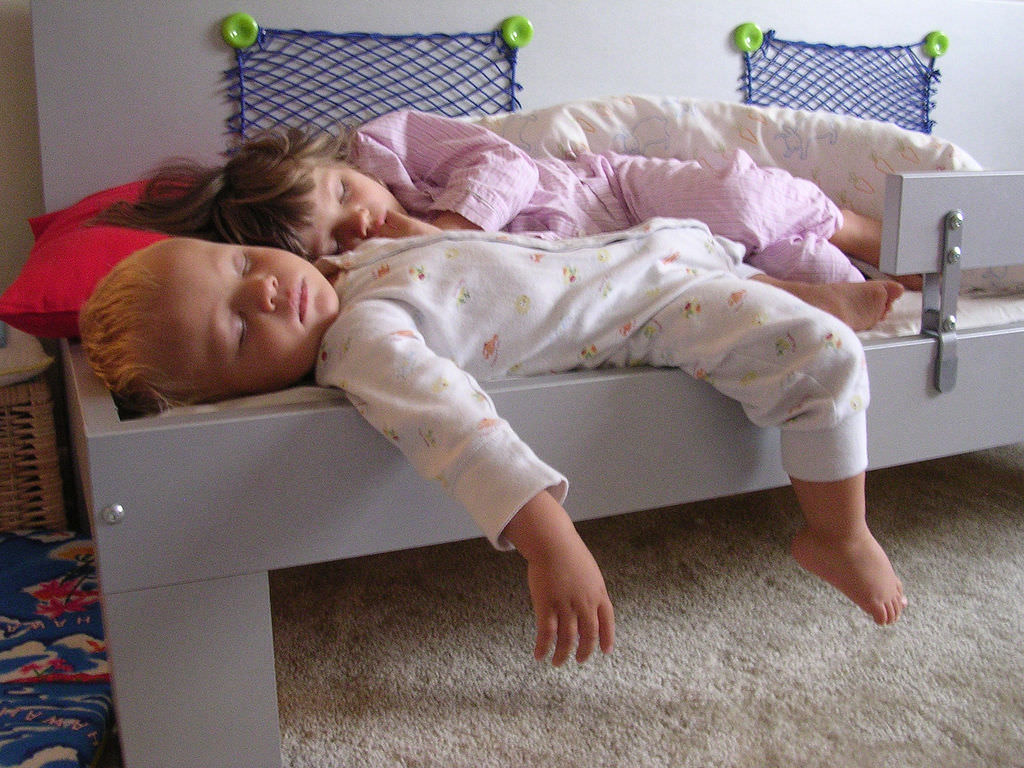 She immediately climbed back out. This is where the ‘real teaching’ comes into play.
She immediately climbed back out. This is where the ‘real teaching’ comes into play.
Let me tell you how it worked with our son (because it explains why we did this again with our daughter) I saw this method on Super Nanny, and I have had to do this with our third son when he was two years old. It works. I promise you. It is ALL ABOUT CONSISTENCY.
After you have verbally corrected them once, from then on, take them by the hand and firmly, but GENTLY place them back into their beds. Do not lose your temper. I did this with our son (when he was two years old) over 100 times!
Now, I know that number sounds outrageous, but on the show, SuperNanny, some parents did it hundreds of times (like 300+).
It works. It really does. (Remember- bad habits can take up to three days to break, so give it three days!)
It just works.
Extreme or not.
I was not mean.
I didn’t use force.
I did not yell.
I was not angry.
I show consistency. How To Get A Child To Stay In Their Bed? (The exact steps)Let me give you an example of one of our sons. I sat outside his door and waited for him to come out again, and again, and again.
It took one night of putting him back to bed over and over and over and over until he stopped coming out.
By night #2, it happened about 10 times.
By night #3- zero times.
It has been several years, and he has not come out of his bed unless he has been sick or scared or had to use the bathroom. If he needs us, he calls for us, but that is not often. After we read with him, give him a sip of water, lie down with him, and sing his goodnight songs, he goes to sleep.
RELATED–>> We also do this trick to help him sleep all night long (if your child wakes up in the middle of the night, this tip is a game-changer! It can help your child sleep all night long!)
You can read about it by clicking on this picture:
So, back to our two-year-old daughter: I did this with our daughter a few weeks ago (the two-year-old) but it only took four times of putting her back into her bed before she figured out that this was not going to work. The promise to leave her door open like her brothers helped, too. Haha!
The promise to leave her door open like her brothers helped, too. Haha!
Other tricks to try:
- Leave the door open
- Leave on a night light
- Skip nap time, but put them to bed sooner (a tired child sleeps well. An over-tired child is restless).
- Use a sticker chart
- Get this noise machine projector (our niece loves this- she is three)
- Or you could get this clock that changes color when they can wake up!
- Remember that this will be hard and tiring, but if you want your child to stay in their own bed, this will hopefully help you to accomplish that. In the end, you need to do what works for you and your family. No matter what you read or hear, make it work for your family.
FOR OUR OLDER KIDS:
Our older kids (born in ’06 and ’08) were coming out of their beds for a drink, a tissue, to say goodnight to the dog again, etc… (it was lasting over an hour some nights!) and we finally said that if they come out when they don’t need anything, we would have to give them an extra “not fun” chore. They could come out & help themselves (use the bathroom, etc…) but to come to get us to tuck them back in for the 9th time in an hour was just too much. It was getting OUT OF CONTROL. This stopped it after day 2 of the chores.
They could come out & help themselves (use the bathroom, etc…) but to come to get us to tuck them back in for the 9th time in an hour was just too much. It was getting OUT OF CONTROL. This stopped it after day 2 of the chores.
PS- here are the affiliate links to the products that I mentioned:
I hope that helped! Remember, don’t let the rules for bedtime interfere with your child’s need for a good snuggle now & then. ♥ Read this one when you have a second:
Need More Advice?
Try These:
1. Join my FREE sleep course (sent via email)
2. Why our kids are in bed by 7:00
3. Mommy, will you lay with me?
MOMMY, WILL YOU LAY WITH ME?
4. Potty Train in a WEEKEND.
© YourModernFamily.com. Content and photographs are copyright protected. Sharing of this article is encouraged and appreciated, copying and/or pasting articles to any social media is strictly prohibited.
Content and photographs are copyright protected. Sharing of this article is encouraged and appreciated, copying and/or pasting articles to any social media is strictly prohibited.
12 ways to teach a small child to sleep at night | e1.ru
Marina Rumyantseva — consultant on children's sleep, member of the Russian Society of Somnologists
Collage: Artem Ustyuzhanin / E1.RU, Anna Rybakova / E1.RU
Share
Four years ago, a young mother from Yekaterinburg, Marina Rumyantseva, encountered because her four-month-old daughter stopped sleeping normally. She often woke up at night, haunted her parents, who had to get up to the child 7-10 times a night.
— Until four months old, my daughter slept perfectly. Wherever you put it, there it will fall asleep. But as soon as she was four months old, the baby seemed to be replaced: she began to wake up more often. Everything that worked before didn’t help anymore,” Marina recalls.
Marina herself almost stopped sleeping, fatigue gradually accumulated.
- I was sick in the morning, I was often in a fainting state. I dozed in the morning while my daughter played on the floor, and looked after her with one eye. The lack of normal sleep affected me physically. I was irritable, there was no mood to play with the child after especially difficult nights, says the young mother.
At first, the parents tried to solve the problem on their own, but it didn't work out. Then they turned to doctors for help to rule out the physiological causes of restless sleep.
- In our case, the daughter was completely healthy, but we were still advised to treat with nootropic substances. We decided to take our time and seek a second opinion. At the same time, I began to study the problems of sleep. That’s how I learned that insomnia can be treated with cognitive behavioral therapy, and only if it doesn’t work, turn to medication,” says Marina.
Marina managed to improve the child's sleep without drugs, while she continued to study the features of insomnia more and more deeply. So the young mother even received a diploma as a consultant in children's sleep. Now Marina herself gives advice to young parents on how to return normal sleep to their children, and maintains a blog about healthy children's sleep on Instagram.
So the young mother even received a diploma as a consultant in children's sleep. Now Marina herself gives advice to young parents on how to return normal sleep to their children, and maintains a blog about healthy children's sleep on Instagram.
We asked Marina Rumyantseva to give some advice for E1.RU readers.
About 50% of children living in megacities experience sleep problems
Collage: Anna Rybakova / E1.RU
Share
— Be prepared for the fact that the first two months the child will often wake up at night. During the day, his sleep will also be erratic. He can sleep for 20-40 minutes, then fall asleep immediately for 2 hours. This is fine. But remember that over time, night sleep should lengthen. You can speed up this process by following some simple rules.
From 2 months I advise you to darken the room as much as possible with thick curtains. So the child will understand that the night has come and he needs to sleep. Of course, the baby will still wake up during the night until he needs nightly feeds. There is no need to turn on the light and start playing with it. Try to feed and lull him in the dark.
Of course, the baby will still wake up during the night until he needs nightly feeds. There is no need to turn on the light and start playing with it. Try to feed and lull him in the dark.
A child will never be tired enough to say, “Mom, I want to sleep. Why don't you carry me to bed?" He still doesn't know how to speak. Therefore, it is important that parents themselves make decisions for their child and anticipate the moment when it will be time for sleep.
Remember that the younger the child, the more vulnerable he is. Five extra minutes - and he has already gone too far, overtired. In this state, it will be difficult to lay it down. Usually the child starts screaming, breaking out, and the mother thinks: “He must not want to sleep!” In fact, he wants to sleep so much that he no longer has the strength.
How do you know when your baby is tired and ready to go to bed?
For children under six months of age, signs of fatigue may be “sticking” (looking at one point), touching the ears, nose, yawning. Also watch the child fall asleep: if he fell asleep calmly in 10-15 minutes, then you put him to bed on time.
Also watch the child fall asleep: if he fell asleep calmly in 10-15 minutes, then you put him to bed on time.
Be prepared that after six months your baby will be more and more reluctant to go to bed. Children think that sleeping is “boring”.
Cool moist air is another condition for the baby to sleep better. The room should be 20-23 degrees Celsius. Before going to bed, the room should be ventilated so that air circulates through it. I also recommend using humidifiers. Due to the dryness of the nasopharyngeal mucosa, a child can automatically touch his nose with his hands, trying to eliminate the interference, and because of this, wake up.
If during sleep the child constantly snores or breathes frequently through the mouth, this is a sign that you need to contact the ENT. Your baby may have obstructive sleep apnea. It is also called "sleep apnea disease". This is when the snoring suddenly stops and there is a frightening cessation of breathing. After that, the sleeping person snores loudly, sometimes tossing and turning, and then begins to breathe again.
White noise is a monotonous sound recorded at different frequencies. The secret is that it allows a person to move more smoothly from one sleep cycle to another. So sleep becomes more restorative. Usually parents use white noise if loud neighbors live nearby or there is construction going on outside the window.
The volume of white noise must not exceed 50 dB, its source must be at a distance of 2 meters from the crib. Many mothers are afraid that this is loud for a child. Actually it is not. I measured the same sounds (surf, driving car) in real life, and they turned out to be much louder - from 60 to 70 dB.
Parents often think that only boys choose the sound of a moving train or car, but this is not true: girls love them too
Collage: Anna Rybakova / E1.RU
Share
During sleep, you can turn on the sound of a vacuum cleaner, extractor hood, running water in the kitchen, wind, waterfall, flying plane and driving car, etc.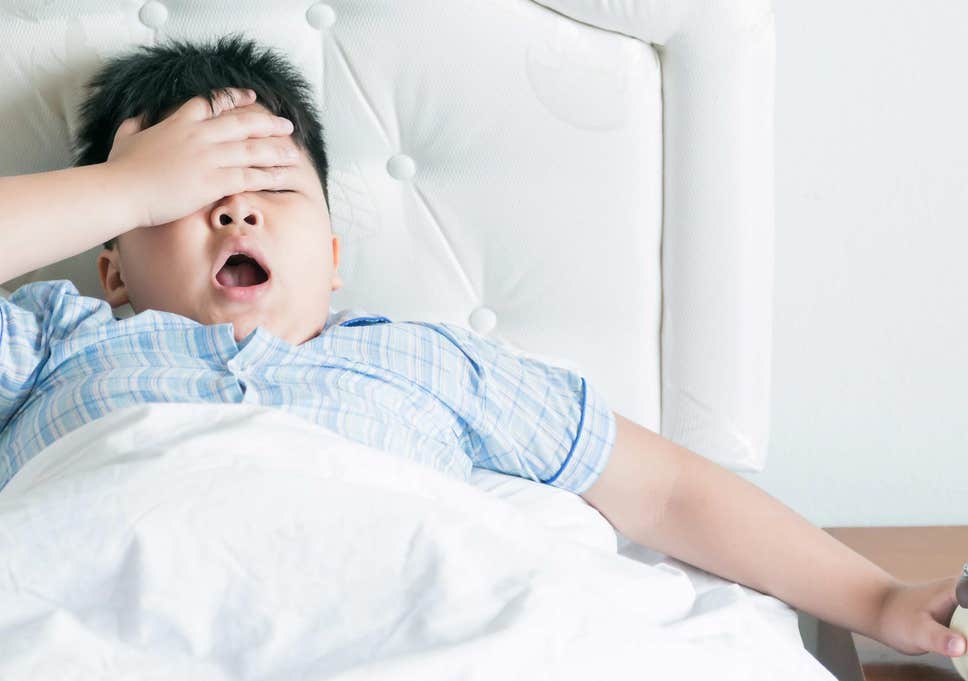 The sound is selected individually depending on what the child likes.
The sound is selected individually depending on what the child likes.
In my practice there was a case when a child protested against any white noise. Whatever sound they turned on, he showed that he did not like it. We went through a lot of options, and when we finally turned on the sound of a moving train, it just went limp. Now he only sleeps with him.
Get your baby to bed with a daily routine - a ritual that you will repeat over and over before bed. Every evening you can read a book, then close the curtains, turn on a dimmed nightlight, feed your baby, get a massage, etc. You can turn on relaxing music or white noise. All this helps hyperactive children calm down, especially if there are guests in the house.
Watching TV before going to bed is not rest. At this time, the child's visual analyzer works, and the brain continues to process information. In addition, TV, like phones and other gadgets, is a source of white light. It disrupts the sleep hormone melatonin. Therefore, it is better not to watch TV at least an hour and a half before bedtime. It is also not necessary to arrange Skype calls with grandmothers at this time, so as not to overexcite the baby.
Therefore, it is better not to watch TV at least an hour and a half before bedtime. It is also not necessary to arrange Skype calls with grandmothers at this time, so as not to overexcite the baby.
It is advisable to turn off the TV during sleep. Many parents think this way: if the child learns to fall asleep under the TV, he will be able to sleep in any conditions. In fact, this is disrespectful to the needs of the child. It is better to create comfortable conditions for him to sleep so that he can recover as much as possible.
One of the problems of megacities is an excess of lighting. Yekaterinburg has a lot of lanterns and luminous billboards. All this also negatively affects the quality of sleep. In front of my house there is a cafe, and above it is a huge LED screen. It shone very brightly both during the day and at night, and at the same time shimmered with different colors. We had to use blackout curtains to sleep well again until it was turned off at night after someone complained.
If you sleep for a long time during the day, then nighttime festivities may begin at night or in the morning. In this case, the time of daytime sleep should be limited. If the baby sleeps for more than 2-2.5 hours, wake him up and play. At the same time, remember that due to age, the child cannot stay awake all day. He will be tired and will not be able to develop normally.
Try to keep your sleep and wake intervals. However, they may change on a case-by-case basis. So, at 4–6 months, a child can have an average of 3–4 daytime sleeps, at 6–8 months - 2–3 daytime sleeps, at 9-13 months - 2 naps. The later you go to one dream, the better. It is good if this happens between the ages of 15 and 18 months. Make sure that the only daytime sleep is at least 2 hours. This will allow the child to sleep.
The graph shows the average values, which in each case may differ depending on the individual characteristics of the child.
Infographics: Anna Rybakova / E1.RU Otherwise, the child may constantly want to sleep, be nervous, scandalize and disobey their parents due to a sharp increase in wakefulness. It is advisable to keep one dream until the child is 4-5 years old (even if it is very short - 40-60 minutes each). The later you give it up, the better.
The total value of the duration of daytime and nighttime sleep
Infographics: Anna Rybakova / E1.RU
Share
At 4 months, a child may suddenly start sleeping for 30-40 minutes, his sleep is fragmented, he does not get enough sleep. There is a regression of sleep - a kind of developmental leap. The problem is that the child still wants to sleep, but he can no longer do it as before, and he still does not know how to sleep differently.
Many old laying methods become worse and worse with time. Therefore, parents need to take the process into their own hands and change tactics. Try putting your baby to sleep as early as possible to lengthen his nightly sleep (up to 10-12 hours).
Try putting your baby to sleep as early as possible to lengthen his nightly sleep (up to 10-12 hours).
When my daughter was 4 months old, we had a classic sleep regression. Perhaps if at that moment we had immediately adjusted the mode and conditions of sleep, many problems with sleep could have been avoided.
Why does the child wake up at night? There can be several reasons: cold or heat, hunger (up to 9–12 months it is quite normal to have nightly snacks), the tummy or teeth are worried, illness, the wrong regimen, accumulated fatigue, overexcitation before bedtime, and more.
Children's sleep is cyclical, it proceeds in waves. The closer the morning, the less its depth and the more restless sleep. Especially if there are errors in the baby mode, then most likely they will appear in the second half of the night.
Another reason is that sleep associations are triggered. This usually happens after 4 months. The baby falls asleep in the arms of his mother, and wakes up in his crib, where he was already transferred to sleep. He opens his eyes, but his mother is not around. He begins to worry: “Where is mom ?!” - and cries.
He opens his eyes, but his mother is not around. He begins to worry: “Where is mom ?!” - and cries.
Experts say that the safest sleeping position for a child is sleeping on the back
Collage: Anna Rybakova / E1.RU
Share
My four-year-old daughter sometimes asks to leave the door to her room open so she can see the light from another room. So she is calmer, and she falls asleep faster. But if at night she suddenly wakes up and does not see the light, she starts screaming: “Who closed the door?” She feels like she has been deceived.
She, like that baby, fell asleep under certain conditions and woke up under different conditions. But she is already four years old, she can speak and express her dissatisfaction with the changed circumstances in words. It is extremely difficult for a small child to do this. He can only show it by crying. But most parents don't understand what that means.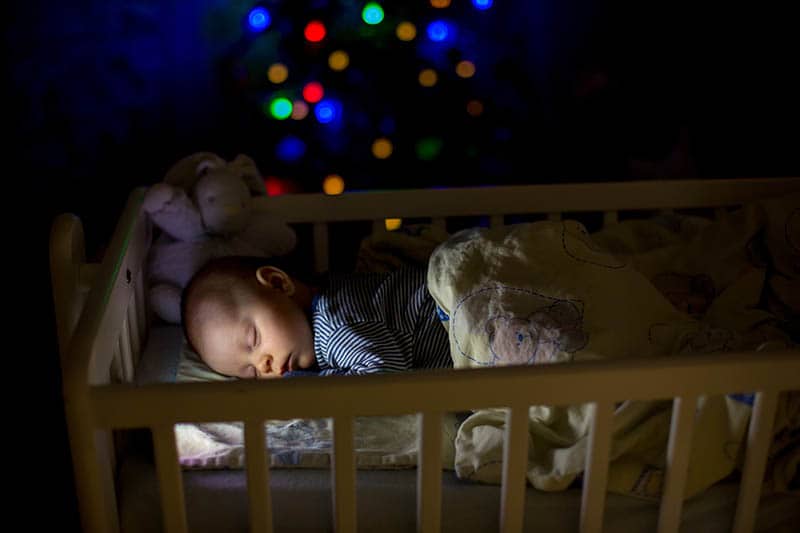
To help your baby sleep peacefully, try putting him to bed sleepy but awake, this way he will wake up in the same conditions as when he fell asleep, and it will be easier for him to fall asleep again without additional help.
Early bedtime is a must for any child at any age. Going to bed early is physiological, because it is caused by the production of certain hormones. In the evening, closer to 21-22 hours, the peak of melatonin production occurs, which is responsible for sleep. In the morning, cortisol is produced, it affects the desire to stay awake. Its peak is at 5-6 in the morning, so parents note that in the second half of the night the child sleeps more calmly.
Try to get your child to sleep by 7:00 pm or 8:00 pm. Then he will get more hours of the deepest and most restorative sleep. From 4-5 months, I would advise putting the baby to bed from 18 to 20 hours so that he has 11-12 hours of sleep. So he will sleep the norm of night sleep and wake up at physiologically active hours.
Early laying has other advantages. Parents have a lot of free time in the evening hours, which they can devote to themselves. One mother whom I consulted once sent me this message: “Marina! I have already managed to do the laundry, watch a couple of episodes of the series, cook dinner and I don’t know what else to do. It's so cool!"
It turned out that motherhood can be completely different, that it is not necessary to suffer, and during maternity leave there may be moments when you can feel like you are on vacation, read a book or watch a series, spend a romantic evening with your husband.
There is such a thing as sudden infant death syndrome. This is when a child dies during sleep for an unknown reason. Approximately one third of infant deaths are due to the fact that the parents did not properly organize the child's bed. For example, a child can suffocate if there are soft objects in the crib (blankets, bumpers) by simply burying their nose in them. A safe crib should contain only a mattress, a taut sheet, and a baby.
If your child sleeps with you, give him a separate place. It's not safe to sleep between mom and dad. The child may roll over several times, fall and end up between the sofa and the wall, suffocate. Clients said that they woke up in the middle of the night, and the child was not around. They began to look for him, and it turned out that he was under the covers - all red, he did not have enough air.
How can I be safe when sleeping together?
Bed rails (net) can be used, which are fixed under the mattress. So you can be sure that the child does not crawl away and does not fall. A contraindication for joint sleep may be overweight of one of the parents (the child may roll in your direction), taking drugs or other drugs that depress the nervous system.
It may be safer to sleep in a side crib that is well attached to yours. The safest sleeping position for an infant is on its back.
Often in the first months after the birth of a child, the mother is deprived of sleep.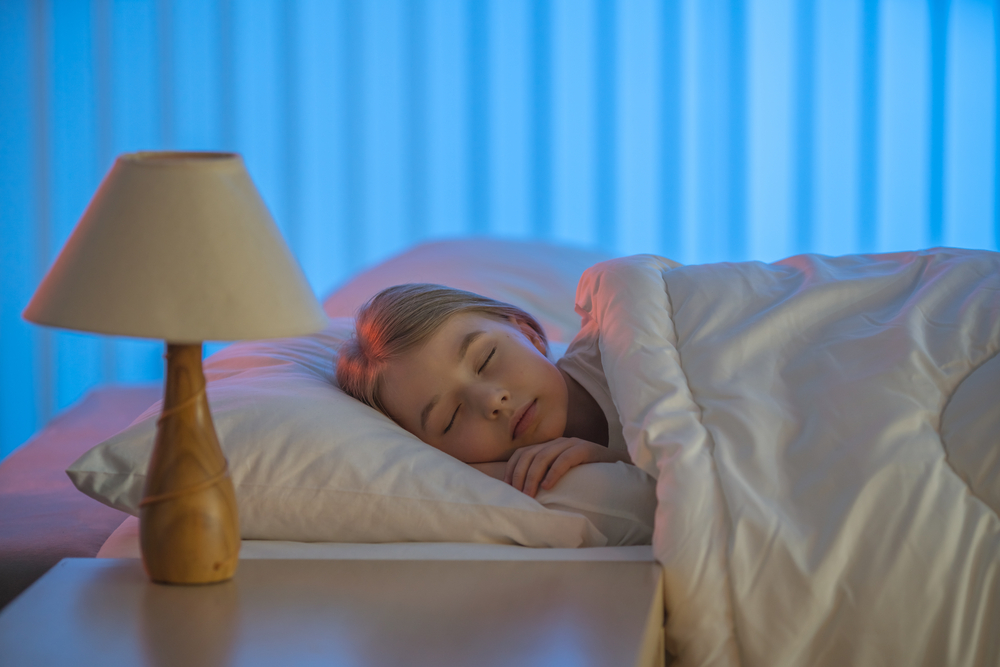 This leads to the fact that over time she accumulates fatigue. Its resources are gradually depleted. This can lead to postpartum depression.
This leads to the fact that over time she accumulates fatigue. Its resources are gradually depleted. This can lead to postpartum depression.
Sometimes mothers come to me and ask me to teach them to love their child again. They say, “I take it out on my child. I hit a toddler recently because I couldn't control my emotions. Help me learn to love a child again.”
I recommend young mothers not to be shy about asking for help from relatives in everyday life or caring for a child, to try to get more rest instead of some non-urgent things. And if you feel something like this (no joy, everything is annoying, you don’t feel love for the child or you constantly break down on him), you need to restore your resource, because in this state, the mother will not be able to help the baby. In such cases, it is best to seek help from a psychologist or psychotherapist.
Earlier we published an interview with the Director of the NII OMM Galina Malgina, who told in detail why mothers kill babies and how to save a wife from postpartum depression.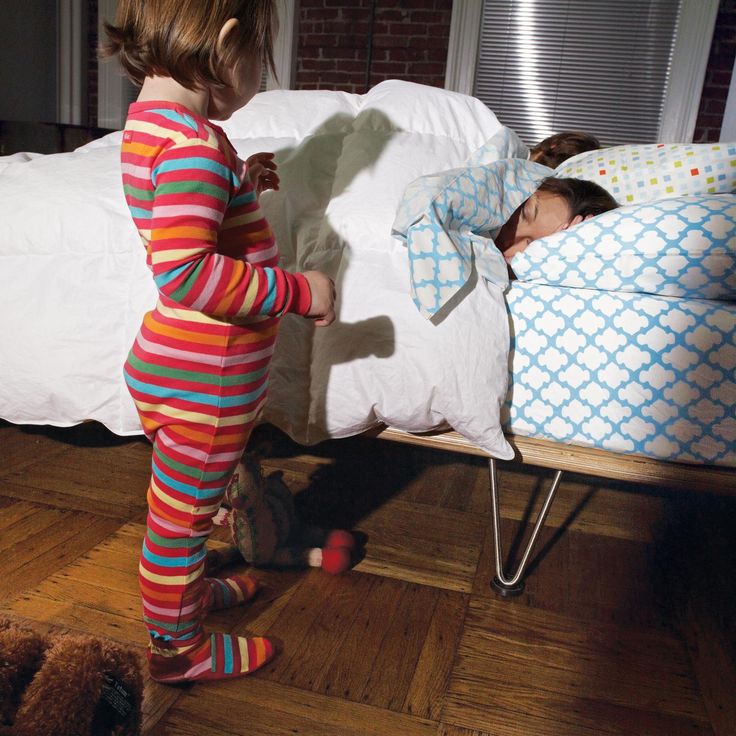 You can read it here.
You can read it here.
You can choose a comfortable baby cot here.
First part. "A large number of cases of enuresis resolve spontaneously"
Up to 15% of children over 5 years of age suffer from enuresis. What is this problem, how to treat it and what not to miss in the behavior and health of children? Galina Evgenievna Tishchenko, neurourologist at GMS Clinic, answers these and other questions of children's health.
It must be understood that by pronouncing the term "enuresis", we mean periodic urinary incontinence during night sleep in children over 5 years old. Everything that concerns the age of up to 5 years, urination during a night's sleep fits into the concept of the norm, and everything that concerns problems with urination, in addition to bedwetting, is no longer monosymptomatic enuresis. That is, there is a complex dysfunction of the lower urinary tract. If we are talking about monosymptomatic enuresis, when children have only incontinence at night, then it occurs in 15% of children at 5 years old, and then this percentage decreases with the age of the child.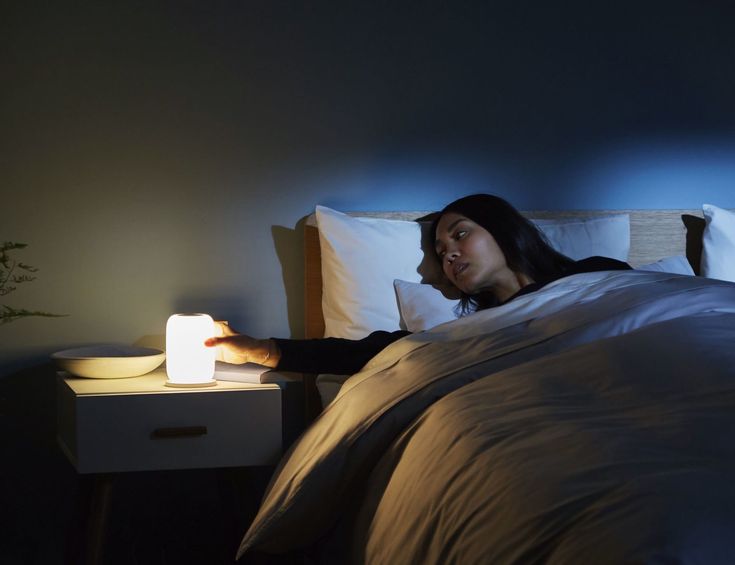 At 6 years -13%, at 7 years - 10%. And by the age of 15, there will be 1% of children who have this diagnosis. For a medical diagnosis, age 5 is the starting point.
At 6 years -13%, at 7 years - 10%. And by the age of 15, there will be 1% of children who have this diagnosis. For a medical diagnosis, age 5 is the starting point.
Why am I paying attention to this? Sometimes parents complain about enuresis, and the child has complex dysfunction of the pelvic organs, and the task of the specialist to whom the parents turned is to determine: does the child really have monosymptomatic enuresis or is there other dysfunction of the lower urinary tract, accompanied by urinary incontinence? In addition, there is also the concept of primary and secondary enuresis.
Primary enuresis is a situation when a child has not previously had a long period (more than 6 months) of dry nights. If there were dry nights for more than 6 months and then enuresis appeared again, then we are talking about secondary enuresis.
Who should pay attention to this?
Along with enuresis, there may be subtle disorders that should be identified by a pediatrician, neurologist, urologist, or a specialist who was initially contacted for help. It is important to ask parents if there are other components of pelvic dysfunction. Does the child have frequent urination (more than 8 times a day)? Or vice versa, too rare urge to urinate (less than 3 times a day)? Do you have urinary incontinence during the day? This is important when a child, by the age of 6-7, can already control urination during wakefulness.
It is important to ask parents if there are other components of pelvic dysfunction. Does the child have frequent urination (more than 8 times a day)? Or vice versa, too rare urge to urinate (less than 3 times a day)? Do you have urinary incontinence during the day? This is important when a child, by the age of 6-7, can already control urination during wakefulness.
Further. Is there a state of urgency? That is, when the urge to urinate occurs abruptly, without a preliminary slight urge, which the child can postpone. And immediately there is a strong unbearable urge that forces the child to urinate without delay. The doctor should ask how the child goes to the toilet during the day? Doesn't he have to strain, grunt, strain his stomach in order to start urinating? Does he have an intermittent stream of urine when the bladder is emptied in several portions. Is there a condition associated with discomfort, cutting, burning, pain, during or immediately after urination. Does the child have constipation or vice versa fecal incontinence?
If signs of any additional dysfunction of the pelvic organs are revealed, this condition is no longer just enuresis, but dysfunction of the lower urinary tract, which is accompanied by a component of urinary incontinence at night.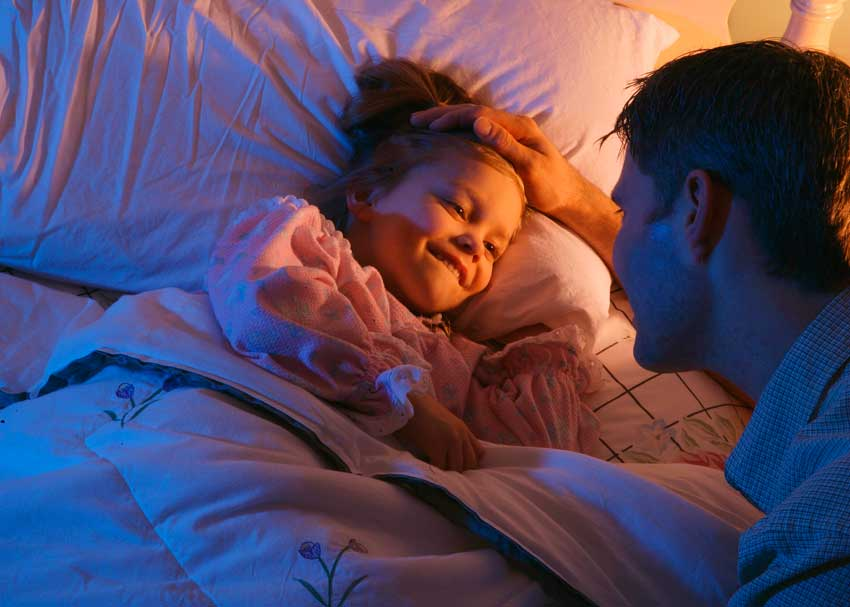
What do doctors have to deal with more often?
In 80% of cases, we meet with primary enuresis, and in 20% with complex enuresis, when there are other symptoms. Among complex cases, in about 15% of children, the problem will be combined with impaired bowel function, that is, urinary incontinence will be associated with constipation. And we say that in general we are dealing with a violation of the functions of the pelvic organs. The doctor must understand this.
It is very important not to miss a congenital anomaly when we are dealing with an incorrect laying of the nervous system and spine, and not just with what lies on the surface.
Which of the children is more likely to have enuresis, and is there a genetic reason for this?
According to statistics, enuresis occurs 2 times more often in boys than in girls. As for the characteristics of children or genetics, there are no obvious causes and relationships.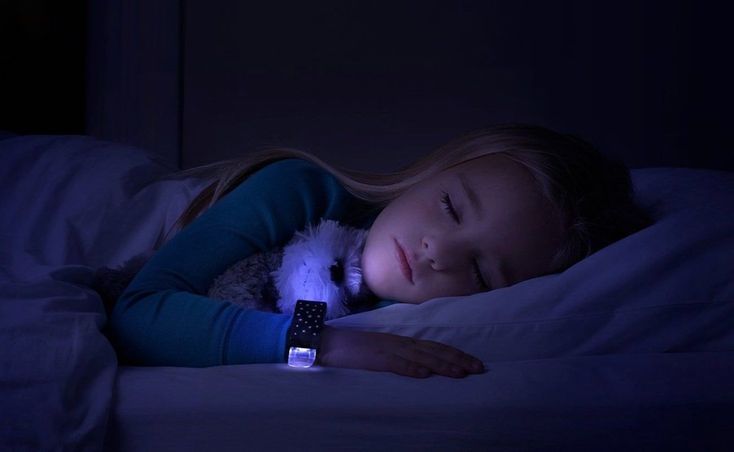 Some scientists have investigated sleep disturbances, suggesting that children with enuresis sleep more soundly than healthy ones. Some children were found to have deeper sleep, they tried to track the connection with the alternation of fast and slow phases of sleep. Some researchers have found that incontinence occurs during REM sleep, and then they got other results. The gene in the chromosomes responsible for the transmission of primary enuresis was examined in families, if there is a mutation of this gene, then the trait will be transmitted to children. In any case, even if there is no genetic predisposition, in 15% of cases, children after 5 years of age will have monosymptomatic enuresis.
Some scientists have investigated sleep disturbances, suggesting that children with enuresis sleep more soundly than healthy ones. Some children were found to have deeper sleep, they tried to track the connection with the alternation of fast and slow phases of sleep. Some researchers have found that incontinence occurs during REM sleep, and then they got other results. The gene in the chromosomes responsible for the transmission of primary enuresis was examined in families, if there is a mutation of this gene, then the trait will be transmitted to children. In any case, even if there is no genetic predisposition, in 15% of cases, children after 5 years of age will have monosymptomatic enuresis.
There have been many studies on urodynamics during night sleep, they are amazing. Scientists installed sensors in the bladder cavity and on the muscles of the perineum, and also filmed brain activity. The wall of the bladder began to tense up, and if another sensor simultaneously recorded a response increase in the activity of the muscles of the perineum, the child remained dry, and if the tone of the perineum did not increase, then there was no signal from the nervous system to hold and urine leaked.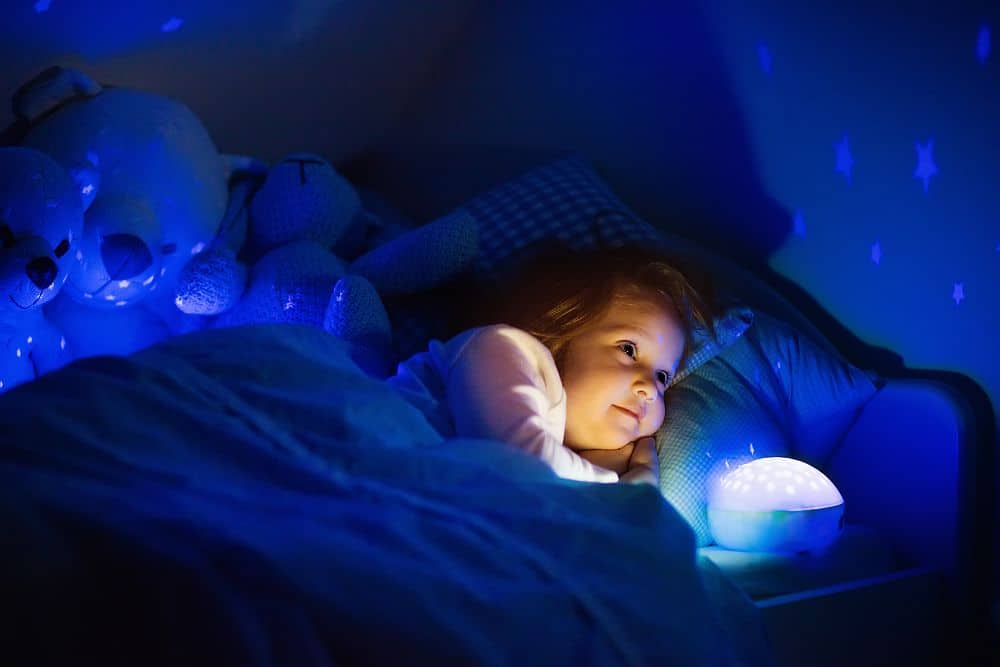 Science still cannot find a connection with the posture in a dream. The main thing is that the urge does not awaken one child, but awakens another, all other things being equal. Why this happens, we do not know. Additional evidence is required.
Science still cannot find a connection with the posture in a dream. The main thing is that the urge does not awaken one child, but awakens another, all other things being equal. Why this happens, we do not know. Additional evidence is required.
It turns out that urination in the body is very complicated?
Urination is one of the most complex organized acts. The muscles of the bladder, the urethra, and the muscles of the perineum must work very, very well together. During the accumulation of urine, the muscles of the bladder remain relaxed, and the sphincter and muscles of the perineum are in good shape, they are clamped, and we are dry all day without thinking about it in the norm. Then the reverse process takes place, but only under our volitional control. Thus, there is a regulation. When the brain decides to urinate, the accumulation phase changes to the urine output phase. This is a complex process in the body. The muscles of the perineum relax, and only after that a signal is given to contract the bladder wall. Urine is excreted. This is the so-called mature type of urination. When a child is unable to retain urine by force of will, it means that his nervous system is not yet mature. And up to 5 years, there is no point in expecting complete control over urination, including at night. The regulatory mechanisms of the body are not yet mature. When a child is already learning to control bowel function, and he does not have incidents with fecal excretion, then, often, in the interval from a month to a year, complete control over the function of urination will develop. And this means that a mature type of urination has been formed. The child will have longer intervals between urges, the capacity of the bladder will increase, the functions of the perineal muscles that hold urine will be coordinated. The pressure inside the bladder will remain low despite the newly arriving urine from the kidneys, and the child will control his urination completely. When the urge to urinate can awaken a child at night, it means that the child already has a mature type of urination.
Urine is excreted. This is the so-called mature type of urination. When a child is unable to retain urine by force of will, it means that his nervous system is not yet mature. And up to 5 years, there is no point in expecting complete control over urination, including at night. The regulatory mechanisms of the body are not yet mature. When a child is already learning to control bowel function, and he does not have incidents with fecal excretion, then, often, in the interval from a month to a year, complete control over the function of urination will develop. And this means that a mature type of urination has been formed. The child will have longer intervals between urges, the capacity of the bladder will increase, the functions of the perineal muscles that hold urine will be coordinated. The pressure inside the bladder will remain low despite the newly arriving urine from the kidneys, and the child will control his urination completely. When the urge to urinate can awaken a child at night, it means that the child already has a mature type of urination.